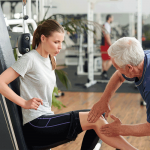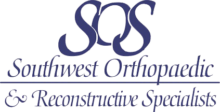Sports Medicine
 From the standard sports to the extreme sports our sports medicine physicians are here for you. With an accurate diagnosis, treatment plans are designed to return you to an active lifestyle. The hardest part of recovery is not over-exercising or returning to the active list to soon. Rehabilitation may start with simple steps or range of motion exercises, but building strength and increasing agility is part of the plan. Playing by the rules for recovery is a big part of recovery.
From the standard sports to the extreme sports our sports medicine physicians are here for you. With an accurate diagnosis, treatment plans are designed to return you to an active lifestyle. The hardest part of recovery is not over-exercising or returning to the active list to soon. Rehabilitation may start with simple steps or range of motion exercises, but building strength and increasing agility is part of the plan. Playing by the rules for recovery is a big part of recovery.Arthroscopic Knee Surgery
Knee arthroscopy is a surgical procedure that allows doctors to view the knee joint without making a large incision (cut) through the skin and other soft tissues. During knee arthroscopy, your surgeon inserts a small camera, called an arthroscope, into your knee joint. The camera displays pictures on a video monitor, and your surgeon uses these images to guide miniature surgical instruments.The doctor can clean up bone fragments and repair some tissues.
ACL INJURY AND RECONSTRUCTION
One of the most common knee injuries is an anterior cruciate ligament sprain or tear. Athletes who participate in high demand sports like soccer, football, and basketball are more likely to injure their anterior cruciate ligaments.
If you have injured your anterior cruciate ligament, you may require surgery to regain full function of your knee. This will depend on several factors, such as the severity of your injury and your activity level.
![]() PLAY THE VIDEO: ACL RECONSTRUCTION
PLAY THE VIDEO: ACL RECONSTRUCTION
Collateral Ligaments are found on the sides of your knee. The medial collateral ligament is on the inside and the lateral collateral ligament is on the outside. They control the sideways motion of your knee and brace it against unusual movement.
Cruciate Ligaments are found inside your knee joint. They cross each other to form an “X” with the anterior cruciate ligament in front and the posterior cruciate ligament in back. The cruciate ligaments control the back and forth motion of your knee.
The anterior cruciate ligament runs diagonally in the middle of the knee. It prevents the tibia from sliding out in front of the femur, as well as provides rotational stability to the knee.
Osteotomies
Osteotomy literally means “cutting of the bone.” to reshaped and relieve pressure on the knee joint. Knee osteotomy is used for shifting weight off of the damaged side of the joint, an osteotomy can relieve pain and significantly improve function in an arthritic knee.
- Patella Stablisation Osteotomy
- Femoral or Tibial Osteotomy
Cartilage Restoration
Because cartilage does not heal itself well, doctors have developed surgical techniques to stimulate the growth of new cartilage. Restoring articular cartilage can relieve pain and allow better function. Most importantly, it can delay or prevent the onset of arthritis.
Sports Medicine Topics
Click on the topics below to find out more from the Orthopaedic connection website of American Academy of Orthopaedic Surgeons.
